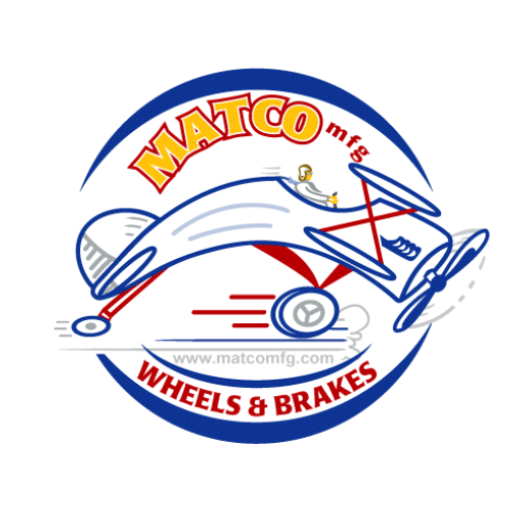Troubleshooting
Wheels
Matco Aircraft Landing Systems wheels using tapered roller bearings are equipped with Timken bearings utilizing integrated grease seals on the bearing cone to ensure the longest possible life. The torqueing procedure for bearings with these type seals is different than for tapered roller bearings without them.
Click Here for full details.
Check to be certain that pressure is not being applied to the brake by a blocked hydraulic line by loosening the bleeder carefully. If brake fluid under pressure is expelled and the wheel now turns freely, check the hydraulic line for the block source. If this did not free the brake, most likely the brake guide tubes are bound up by the brake plate anchor. Fix this by cleaning any rust deposits off and lubricating the brake guide tubes. Check to ensure that the brake plate anchor Is not deforming when the bolts are tightened against the axle head. Some shimming may be required to ensure a flat fit.
Use a thread sealant on any tapered pipe fittings that is compatible with petroleum such as LockTite 567 Thread Sealant. Do Not use Teflon tape as it can be cut during installation and enter your hydraulic system.
Brakes
Check to ensure that there is no air in they system. Air can be trapped in any high spot in the line and often cannot be “pumped” out. Ensure no high spots during bleeding. Follow the Brake Bleeding Procedure for more details.
There are many types of line material that can be used. The line should have a working pressure of at least 425 psi and a burst pressure greater than 1500 psi. Care should be taken in the installation to reduce the installed stress on the line by keeping bend radii as large as possible. This is especially true at the fittings. Thought should be given to the orientation of the fittings at the caliper to best align with the approach of the hydraulic line to minimize the stress on these important fitting. Also, the lines should be routed to be clear of rotating components of the brake for consideration of potential damage from interference as well as heat induced stress from proximity. Solid lines of aluminum or steel as well as braided stainless line or nylon line are available in these pressure ranges and can be suitably engineered for installation with the proper consideration. All lines are not alike and the user must be certain to select lines of the proper rating. Also, keep in mind that the caliper must be free to float in the brake plate. The caliper housing will move away from the disc as the pads and disc wear. This distance will be one half the total of the pad and disc wear and must be accounted for in the installation.
Master Cylinders
Overfilling is the primary reason for leaking around the shaft. Since the master cylinder vents around the shaft, the fluid level should be only 3/4 full to allow for master cylinder travel with the rudder pedals. The MATCO master cylinder is designed to function within fifteen degrees of vertical. If you cannot install within fifteen degrees of vertical, use a remote reservoir master cylinder.
MATCMatco Aircraft Landing Systems. uses 1/8 tapered pipe fittings for all fittings.
Your hydraulic system is designed to allow it to self adjust as the pads wear. This is accomplished by having a by-pass valve in the master cylinder that opens to the reservoir when the master cylinder is at rest and the shaft is fully extended. With the by-pass open, the reservoir is connected to the hydraulic system and allows fluid to flow into the portion of the system below the master cylinder and supply additional fluid required as the brake linings wear and the brake pistons extend. The fluid can only flow to the lower portion if the system is vented. For aerobatic use, the vent may be plugged but will need to be manually vented (cap opened) after 15-30 landings or the cylinder may begin to draw a vacuum and introduce air into the system from the master cylinder end gland shaft seal.
For any questions not covered here, contact our technical support department.
